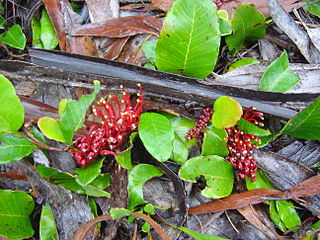
Grevillea tetragonoloba is species of flowering plant in the family Proteaceae and is endemic to the southwest of Western Australia. It is a dense, erect to spreading shrub, usually with pinnatipartite to almost pinnatisect leaves, the end lobes linear, and clusters of yellowish-brown to fawn flowers with a scarlet to orange-red style.

Grevillea levis is a species of flowering plant in the family Proteaceae and is endemic to the west of Western Australia. It is a dense shrub with divided leaves, the end lobes linear and sharply pointed, and clusters of white to cream-coloured flowers, sometimes flushed with pink.

Grevillea venusta, commonly known as Byfield spider flower, is species of flowering plant in the family Proteaceae and is endemic to a small region of central eastern Queensland. It is an erect shrub with simple and/or divided leaves, the leaves or lobes narrowly oblong to narrowly elliptic, and clusters of green and yellow flowers with a deep maroon to purplish black style covered with white hairs.

Grevillea agrifolia, the blue grevillea, is a species of flowering plant in the family Proteaceae and is native to the north of Western Australia and parts of the Northern Territory. It is a shrub or tree with narrowly oblong leaves with the narrower end towards the base, and creamy-yellow flowers.

Grevillea rivularis, commonly known as Carrington Falls grevillea, is a species of flowering plant in the family Proteaceae and is endemic to New South Wales. It is a dense, spreading shrub with divided leaves with more or less linear, sharply-pointed lobes, and clusters of cream-coloured flowers that turn pink or grey as they age.

Grevillea laurifolia, commonly known as laurel-leaf grevillea, is a species of flowering plant in the family Proteaceae and is endemic to New South Wales. It is a prostrate, trailing shrub with egg-shaped, heart-shaped or round leaves, and clusters of reddish to deep maroon flowers.

Grevillea pachylostyla, commonly known as Buchan River grevillea, is a species of flowering plant in the family Proteaceae and is endemic to Victoria in Australia. It is a mounded to almost prostrate shrub with divided leaves, the end lobes triangular, and usually down-curved, more or less toothbrush-like clusters of cream-coloured flowers that turn` pink to red after opening.
Grevillea hockingsii is a species of flowering plant in the family Proteaceae and is endemic to south-eastern Queensland. It is an erect shrub with oblong to narrowly elliptic leaves and clusters of reddish-pink flowers.
Grevillea kedumbensis is a species of flowering plant in the family Proteaceae and is endemic to a restricted locale in the Great Dividing Range in central New South Wales in Australia. It is a twiggy shrub with narrowly elliptic to egg-shaped leaves with the narrower end towards the base, and clusters of hairy green to cream-coloured flowers.
Grevillea kirkalocka is a species of flowering plant in the family Proteaceae and is endemic to inland Western Australia. It is a low, spreading shrub with divided leaves with sharply-pointed linear lobes and clusters of red flowers.

Grevillea plurijuga is a species of flowering plant in the family Proteaceae and is endemic to southern Western Australia. It is a prostrate to low-lying or dense mounded to erect shrub with divided leaves with linear lobes and loose clusters of hairy, red or pink flowers.
Grevillea glabrescens is a species of flowering plant in the family Proteaceae and is endemic to the Northern Territory. It is an open, erect shrub with oblong leaves that have triangular teeth or lobes on the edges, and clusters of white to cream-coloured or very pale yellow flowers.
Grevillea rhizomatosa, commonly known as Gibraltar grevillea, is a species of flowering plant in the family Proteaceae and is endemic to a restricted area of north-eastern New South Wales. It is a spreading, bushy shrub with egg-shaped to almost round leaves and small clusters of green and pinkish-red flowers.

Grevillea quadricauda, commonly known as four-tailed grevillea, is a species of flowering plant in the family Proteaceae and is endemic to eastern Australia. It is an erect, dense, bushy shrub with narrowly egg-shaped to elliptic leaves and small, loose clusters of green and pinkish-red flowers.

Grevillea masonii, commonly known as Mason's grevillea, is a species of flowering plant in the family Proteaceae and is endemic to a restricted area of New South Wales. It is a low-growing shrub with egg-shaped to elliptic leaves, and red and green flowers with a green style.
Grevillea nivea is a species of flowering plant in the family Proteaceae and is endemic to the south of Western Australia. It is a dense shrub with spreading to ascending branches, crowded, divided leaves, the end lobes linear, and dense clusters of red flowers.

Grevillea obliquistigma is a species of flowering plant in the family Proteaceae and is endemic to the south-west of Western Australia. It is a spreading shrub with linear leaves, and conical to cylindrical clusters of creamy-white to yellowish cream-coloured flowers, sometimes tinged with pink.

Grevillea rara, also known as the rare grevillea, is a species of flowering plant in the family Proteaceae and is endemic to a restricted part of the South West region of Western Australia. It is a prostrate, sprawling shrub when young, later a dense, prickly shrub with pinnatisect leaves with linear lobes, and clusters of white to pale pink flowers.
Grevillea xiphoidea is species of flowering plant in the family Proteaceae and is endemic to a restricted part of inland areas of Western Australia. It is a dense shrub with divided leaves, the end lobes linear and sharply-pointed, and loose clusters of white to cream-coloured flowers.

Grevillea neodissecta is a species of flowering plant in the family Proteaceae and is endemic to Western Australia. It is low, dense shrub with deeply divided leaves, the end lobes linear and sharply pointed, and small clusters of rose pink and white to cream-coloured flowers with a pinkish-red style.













